A mascot is a person, animal, object, or an imaginary figure used as a representative symbol by a community or an organization. The mascot is supposed to bring luck, somewhat like a totem or amulet. Whereas totems and amulets have been in use since ancient times, the use of mascots is relatively quite recent. The Olympic Games, for example, had originally the torch and interlocked five rings as mascots only, but after 1972, many mascots like: Dachshund Waldi, Snowman, Hidy and Howdy, Roni the Raccoon, and the four Snowlets were used in the Olympic Games. Many food producers, particularly the breakfast cereals producers, used the mascots to promote and market their products, and this proved to be a very successful marketing strategy. Parents are decision makers for buying the cereals, but kids are the real decision makers for their brands. Kids are highly imaginative, and the lively mascots with brilliant colors appearing on the packages are simply irresistible for them. This imaginative approach of kids establishes the brand loyalty of many cereal products. Cereals like; wheat, maize or corn, rice, barley, oats, sorghum, millet, rye, and many others are highly nutritious foods; therefore, they are a staple to many communities in the world.
1. Quaker Oats Man

The Quaker Oats Man is the oldest cereal mascot in America. It was registered in 1877. Quakers are members of the religious Society of Friends, and the mascot was chosen to suggest honesty, integrity, and purity. Or, in other words, to suggest quality. The original mascot was created in 1877. Jim Nash, a graphic designer, developed a black-and-white version of the current mascot in 1946. Haddon Sundblom developed a colored mascot from the line drawing. The Society of Friends went to court to disassociate their name from the cereal product, but the court did not accept their plea. Quaker Oats was one of the first few food companies to introduce a convenience food with an emphasis on time saving, and the concept later developed into an instant formula and fast foods. Quaker Oats launched their product ‘Quick Oats’ in 1922. The Quaker Oats Man mascot is iconic to breakfast cereals.
2. Sugar Bear
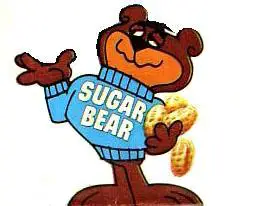
Sugar Bear was a cartoon mascot created by a graphic designer, Robert Irwin, for Post Cereal. The figure was shown wearing a blue turtleneck sweater with the name on the front. A bite of Super Sugar transformed him into a Super Bear. Sponsored by General Foods, the advertisement including Sugar Bear appeared for the first time in the Saturday morning cartoon Linus the Lion Hearted in 1964. Granny Goodwitch was a main opponent of Sugar Bear, and this elderly witch wanted to get the box of cereals from the Sugar Bear using witchcraft and technology but failed. Another opponent was Sugar Box who tried to keep the cereal box out of anyone’s reach but always failed to prevent the Sugar Bear from having access to the cereal box.
3. Count Chocula

Count Chocula is a cartoon vampire mascot of a popular product of General Mills monster cereals. The name is a pun on the vampire Count Dracula. It was voiced by Larry Kenny and was introduced in 1971. Count Chocula was produced around the year according to General Mills, but its production increases exponentially in autumn during Halloween. Television advertisements featured the monsters competing for the cereals. The tagline for this mascot is ‘I want to eat your cereal!’
4. Frankenberry
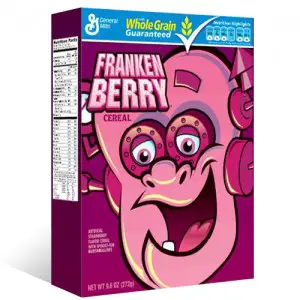
Frankenberry is one of the first two products of General Mills belonging to the cereal line of monsters. The strawberry-flavored product was introduced in October, 1971. Frankenberry is also the name of the mascot. According to fictitious sources, the mascot was created by Count Dracula who consulted his manual; ‘Creating Monsters From Human Corpses for Dummies.’ And while digging the graves, he collected body parts and created the butt-headed mascot using the relevant body parts. Frankenberry is a pink version of the Frankenstein monster who loves strawberries and was launched after Count Chocula. The product had red dye which was not absorbed by some consumers and was excreted as such coloring in the feces. The mascot’s voice was by Bob McFadden.
5. Snap, Crackle, and Pop
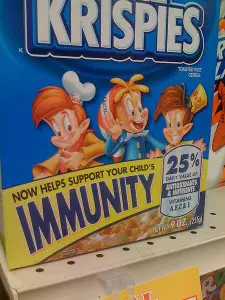
Snap, Crackle, and Pop are cereal mascots relating to Kellogg’s cereal Rice Krispies.The trio looks like brothers; Snap being the eldest and problem solver, Crackle is the middle one, while Pop is the youngest and mischievous. The characters were developed by an illustrator Vernon Grant in 1930. These characters first appeared in the Children’s TV program the Howdy Doody Show. The gnomes had been voiced by different people, and in 2009 Snap, Crackle, and Pop were voiced consecutively by Andy Hirsch, Danny Cooksey, and Mark Ballou.
6. The Trix Rabbit
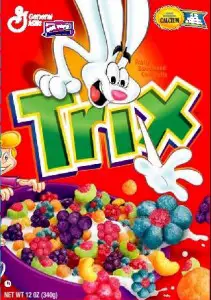
The Trix Rabbit is a mascot for a breakfast cereal brand called Trix produced by General Mills and Nestle. The Trix Rabbit cartoon, having human characteristics, was created by Joe Harris and voiced by Delo States, Mort Marshall, and Russel Horton at different times. The rabbit appeared for the first time in the Trix Television commercial in 1959. He played tricks with children to get their bowl of cereal. The product contains fruit-flavored ground corn pieces mixed with sugar. The product was later on changed to puffed fruit-shaped pieces. Trix has many flavors including: orange, strawberry, raspberry, grape, lime, watermelon, and wild berry.
7. Tony the Tiger
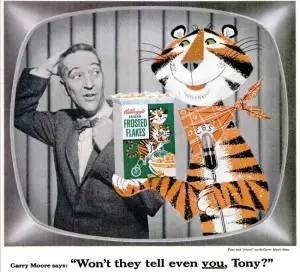
Tony the Tiger is a cereal mascot cartoon representing Kellogg’s breakfast cereal Frosted Flakes better known as Frosties. Tony the Tiger appeared for the first time in radio and television advertisements in 1951. It also appeared on the packaging and has been attracting kids one after another generation. The mascot is iconic to breakfast cereals, and different personalities of radio and television like Garry Moore and Thurl Ravenscroft have portrayed and voiced this character. The mascot was created and named by the graphic artist and art director Eugene Kolkey in 1951.
8. L. C. Leprechaun
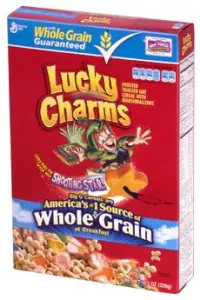
The leprechaun in the guise of an old man wearing a green or red coat is an Irish folklore elf. He enjoys sharing mischief with others. The leprechaun is always busy making shoes and storing his coins in a hidden gold pot at the end of the rainbow. If trapped by human beings, he has the magical power to grant three wishes in exchange for his freedom. L. C. Leprechaun is a mascot for Lucky Charms, a breakfast cereal product of General Mills. The Lucky Charms cereal is made of frosted whole oats and is enriched with vitamins. The mascot debuted in 1964 and proved to be an effective advertisement.
9. Dig’em Frog

Dig’em Frog was the mascot of Kellogg’s sweetened, puffed wheat breakfast cereal originally called Sugar Smacks and later changed to Honey Smack because mothers had reservations for the sugar labeled product. The product practically contained about 50 percent sugar. The mascot Dig’em Frog wears a baseball cap in an oblique position. The mascot was changed to a bear when the name of product was changed from Sugar Smacks to Honey Smacks, but it was soon reverted to Dig’em Frog on account of its popularity. Some people think that the mascot and related advertisement has deliberately ignored the African-American culture as indicated by the prominent ending with ‘g’ in Dig’em which is unlike the African-American convention, and the complete absence of any African-American throughout the campaign.
10. Cap’n Crunch
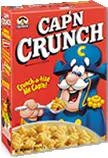
Cap’n Crunch cereal is a product of Quaker Oats. It is a sweetened oat and corn breakfast cereal. Captain Horatio Magellan Crunch, better known as Cap’n Crunch, is the mascot of the Crunch cereal product line. The mascot was created by Jay Ward and aired for the first time in 1963. Cap’n Crunch sailed with a crew of four children; Alfie, Brunhilde, Carlyle, and Dave on his ship the Good Ship Guppy. A pet sea dog also was on board with the crew. The crew was assigned to keep the cereals safe from the Captain’s arch enemy, Jean le Foote who was a barefoot pirate. Cap’n Crunch solved the problems of teenagers by offering them a bowl of Crunch Cereal.
Conclusion:
Since the wisest plans are susceptible to failure, people take into consideration the luck factor. Depending upon the nature of the plan and the planner, different ways and means are used to take care of this dimension. No one reads the numbers on a currency note; it is simply the first glimpses over it that lets people know its value. Regardless of the parent’s concerns, the end user of cereals, especially kids, are the least concerned with its nutritional facts and are most interested in the mascot appearing on the package. And its first glimpses attracts the kid and facilitates the decision making regarding its purchase. Mascots become the unique identity of the products and, once established, it is not an option to change them without causing heavy losses, mostly to the limits of being unaffordable.










October 7, 2012 6:46 pm
Love it! My faves were the Trix Rabbit, Cap’n Crunch, and the Rice Krispies trio 🙂